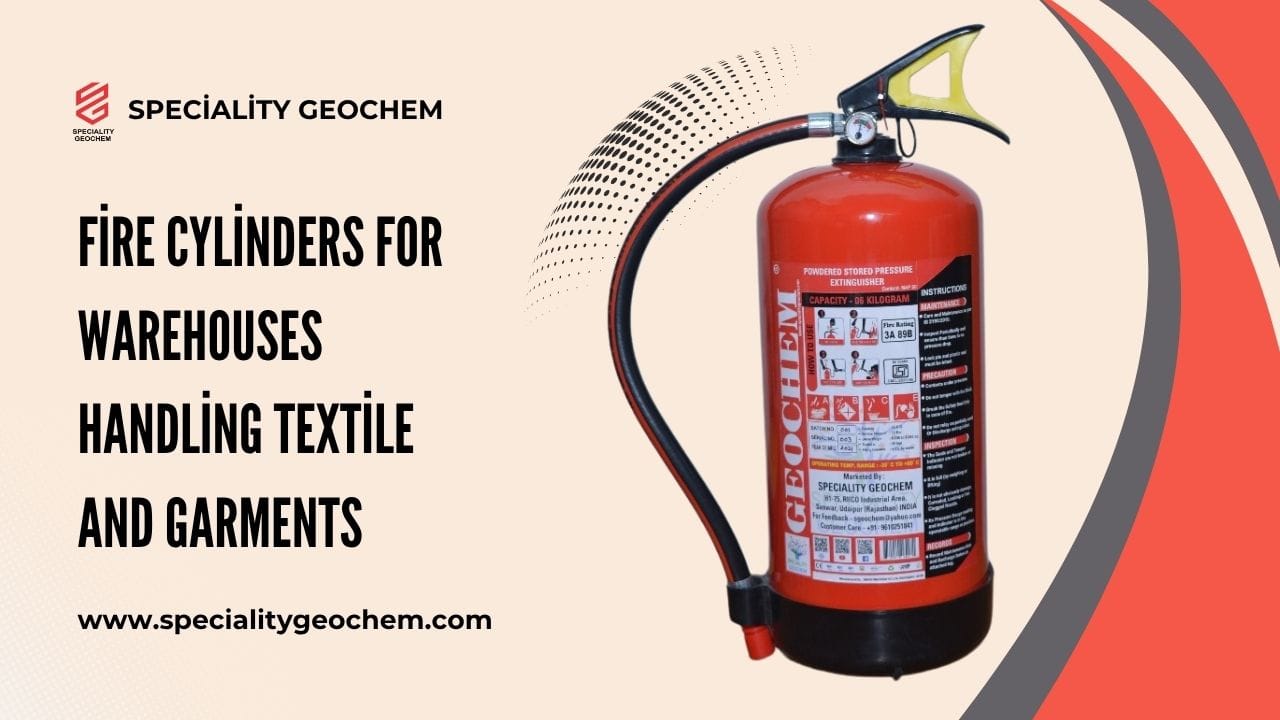Textile and garment warehouses are the backbone of the global fashion and apparel industry. These facilities store tons of fabrics, finished garments, threads, packaging materials, and accessories—all of which are highly combustible. A single spark can spread rapidly through cotton bales, polyester rolls, or cardboard packaging, leading to catastrophic losses. To prevent such incidents, fire cylinders for warehouses play a vital role in ensuring safety, compliance, and uninterrupted operations.
In this article, we will explore the unique fire risks faced by textile and garment warehouses, the importance of fire cylinders, and how businesses can build a reliable fire protection system tailored to their industry needs.
Fire Risks in Textile and Garment Warehouses
Warehouses that handle textiles face fire hazards far greater than many other industries. Some of the key risk factors include:
- High flammability of textiles: Cotton, silk, rayon, and polyester ignite quickly and burn intensely.
- Dense storage conditions: Fabrics are often stacked in bulk, creating a large fire load.
- Dust and lint accumulation: Fibers can accumulate in air ducts, machinery, and electrical panels, becoming ignition sources.
- Electrical hazards: High-capacity lighting, HVAC systems, and machinery increase the risk of short circuits.
- Packaging and chemicals: Cardboard boxes, plastic wrappings, and dyes add to the flammability.
Because of these risks, relying solely on manual extinguishers is not enough. Automated suppression systems and strategically installed fire cylinders for warehouses are a necessity.
What Are Fire Cylinders?
Fire cylinders, also known as fire extinguisher cylinders, are pressurized containers filled with extinguishing agents such as dry chemical powder, CO₂, or clean agent gases. Unlike handheld extinguishers, these cylinders can be installed in fixed locations and integrated into automated suppression systems. Once heat or flame is detected, the cylinder releases its contents to suppress the fire before it spreads.
For textile and garment warehouses, dry chemical powder and CO₂ cylinders are commonly used because they can effectively deal with Class A (combustible materials) and Class C (electrical) fires.
Why Fire Cylinders Are Crucial in Textile Warehouses
- Immediate Response
Fire spreads quickly in fabric storage areas. Fire cylinders provide rapid, localized suppression that buys critical time until firefighters arrive. - Asset Protection
Fabrics, garments, and raw materials represent millions of rupees in inventory. Protecting them is crucial to avoid financial losses and disruption of supply chains. - Worker Safety
Warehouse staff, loaders, and supervisors work in close proximity to these materials. Fire cylinders enhance workplace safety by reducing fire intensity at the source. - Regulatory Compliance
Fire safety audits and government inspections require textile warehouses to install adequate firefighting equipment. Cylinders ensure compliance with safety codes. - Insurance Benefits
Businesses equipped with fire cylinders for warehouses often receive reduced insurance premiums due to their proactive safety measures.
Types of Fire Cylinders for Textile and Garment Warehouses
- Dry Chemical Powder Cylinders
Effective against Class A, B, and C fires. Suitable for fabrics, plastics, and electrical equipment. - CO₂ Cylinders
Best for electrical panel rooms and areas with sensitive equipment. Leaves no residue, preventing fabric contamination. - Water Mist Cylinders
Use fine water droplets to cool and suffocate flames. Effective for cotton and natural fibers but not recommended near electrical points. - Clean Agent Cylinders
Non-toxic and eco-friendly, ideal for premium fabric storage or showrooms attached to warehouses.
Installation Strategies in Textile Warehouses
Installing fire cylinders strategically is as important as selecting the right type. Here’s how textile warehouses should plan:
- Entry and exit points: Cylinders should be placed near loading bays and doors for quick access.
- High-risk zones: Electrical panels, generator rooms, and HVAC units should have dedicated CO₂ or clean agent cylinders.
- Fabric storage racks: Install overhead suppression systems with interconnected fire cylinders for large storage areas.
- Chemical sections: If dyes or solvents are stored, specialized powder cylinders should be nearby.
- Employee zones: Staff rest areas and offices should also be protected.
Maintenance of Fire Cylinders
Textile warehouses often run 24/7, meaning fire safety equipment must always be ready. Maintenance includes:
- Regular pressure checks and refilling.
- Inspection of hoses, valves, and nozzles.
- Ensuring cylinders are accessible and not blocked by stock.
- Conducting mock fire drills to test readiness.
Case Study: Fire Incidents in Textile Warehouses
Several global fire incidents highlight the importance of prevention:
- In Bangladesh, fires in garment factories have caused major losses of life and property due to poor fire protection.
- In India, several textile warehouses have faced devastating fires, often due to overloaded electrical systems and lack of suppression systems.
These incidents underline why fire cylinders for warehouses are not just regulatory tools but life-saving investments.
Building a Complete Fire Safety System
While fire cylinders form the backbone of warehouse safety, they should be integrated into a wider system that includes:
- Smoke and heat detectors
- Automatic sprinkler systems
- Alarm and evacuation protocols
- Training programs for staff
This layered defense ensures maximum protection.
Future of Fire Protection in Textile Warehouses
Technology is evolving rapidly in the field of fire suppression:
- IoT-enabled fire cylinders that send alerts when pressure drops.
- AI-based fire detection integrated with CCTV.
- Eco-friendly agents that reduce environmental impact.
As the textile industry expands globally, modern fire safety systems will become even more essential.
Conclusion
At Speciality Geochem, we understand that textile and garment warehouses face some of the highest fire risks in the industrial sector. With large volumes of flammable fabrics, electrical installations, and chemical storage, even a small incident can escalate into a devastating fire. That’s why the installation of fire cylinders for warehouses is not just a precaution—it is a necessity.
By combining advanced fire cylinders with proper placement, routine maintenance, and intelligent detection systems, businesses can create a strong line of defense against fire outbreaks. This proactive approach not only safeguards valuable inventory but also ensures the safety of employees and long-term operational continuity.
For textile warehouse owners and managers, the choice is simple: prioritize safety with reliable fire protection solutions. Partnering with Speciality Geochem means investing in proven fire safety systems that protect assets, lives, and the future of your business.

